
Cycling from Denmark to Narva.
I just got back from a memorable cycling trip, from Faaborg in Denmark to Narva in Estonia.
These are a few impressions from my 1300 kilometre cycling trip through Northern Europe.
It all started in a Copenhagen cafe.

Hannah and Filip in front of the cafe.
I have, for almost 20 years, been co owner of a little travel cafe in Copenhagen called Cafe Globen. In May 2024 we had a visitor from Estonia called Hannah Wiiberg, giving a presentation about her part of Estonia called Ida-Virumaa.
The place looked very interesting. And since I have been tour cycling for many years, in more than 50 countries, but not Estonia, I got the idea to take a cycling trip to the area that Hannah comes from.
The Estonian consul in Denmark, A Danish man called Filip Daltur Rasmussen, was also present at the cafe meeting. I have known Filip for a few years and we all soon agreed that I should take a cycling trip from Denmark to Narva, where Filip and Hannah would help me with some practical issues and try to connect me with some interesting locals, once I got to Ida-Virumaa, which is the region where Narva is.

Leaving my hometown Faaborg by ferry.
I started the trip the day before I turned 55.
I left Denmark on July 31st, from my hometown Faaborg, in southern Denmark. I started off by taking a ferry to the island Ærø. Many non-Danes are not aware that Denmark is a nation of many small islands. I actually cycled across 7 islands before I left Denmark. I first passed by the picturesque town of Ærøskøbing, where I had lunch at a restaurant called Landbogården. It is owned by a wonderful couple that I know and they serve traditional Danish food with a twist. Great place that I can only recommend.

Ærøskøbing.
Next stop was the tiny island of Skarø. My main reason to include this island in my cycling journey is because I have two cousins living on the island that I always enjoy to visiting. Skarø only has 19 inhabitants. But I happened to visit Skarø when they had the annual music festival on the island. That weekend the number of people on the island goes up to around 1500.
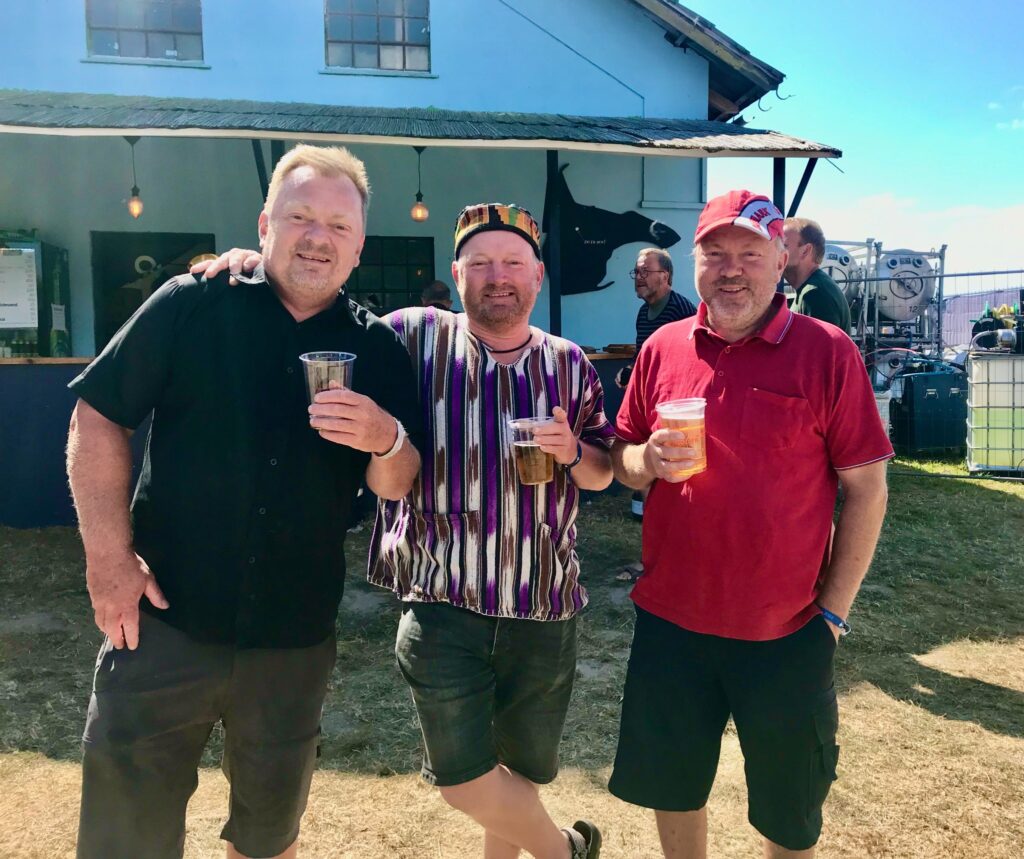
Me and my 2 cousins on the small island of Skarø.
It also happened to be my 55th birthday when I visited Skarø 🙂
Having spent a night on Skarø, having some food and drink with my cousins Poul and Martin, I continued across Denmark.
I passed the islands of Tåsinge, Siø (Siø only has 16 inhabitants), Langeland and Lolland, using ferries and bridges.

Visiting the Estonian consulate at Jungshoved in Denmark.
As I got closer to Copenhagen, I cycled past the residence of Filip Daltur, the Estonian consul. I spent a night camping out in his garden, after having a wonderful dinner with him and his family. Next I rode through Copenhagen to Helsingør, where I finally left Denmark, taking the ferry to Helsingborg in Sweden.

Very Swedish Road sign.
Sweden is paradise for wild campers.
Sweden is very different from Denmark, having a lot more space, as the country is almost 10 times bigger than Denmark, but only has a population that is about twice the one of Denmark. This means that wild camping is inevitable. And it is also legal to camp wild in Sweden, as long as you stay away from private property and leave the place where you camp as you found it.

Wild camping in Sweden.
I quickly got into the camping mood and camped the first night by a little lake, near a small town called Markaryd. Absolutely fantastic to camp. I was all alone by a little lake, with no one but a dog walker, in the early morning hours, passing by my tent.

Cycling across Sweden.

Late at night by a little lake in sweden.
Heading further up north in Sweden, I cycled along Lake Vättern. The second largest lake in Sweden.

Rural Sweden.
Passed by the cities of Linköping and Norrköping, which I both liked a lot. I even gave it an extra day in Norrköping, before I headed up towards Stockholm as Norrköping is a place that has changed a lot for the better, since I was last there, more than 3 decades ago.

Reaching Stockholm, I spent a day in this wonderful city, which is absolutely marvellous, especially on a sunny day, like I had.

Stockholm.
From Stockholm there is a ferry to Tallinn. This is an overnight ferry that is more like a cruise ship. I bought a ticket, where I had my own cabin and it was just like being on a little cruise. The ship was awesome, with a sundeck and several restaurants and cafes.
As you are leaving Stockholm by ship, you are passing an archipelago which is absolutely stunning. It is seriously one of the most scenic sea journeys in all Europe. Taking the ferry between Stockholm and Tallinn (Or for that matter Finland) is worth it, just because of the fantastic scenery, when leaving Sweden.

On the ferry between Stockholm and Tallinn.
After a good night’s sleep in my cabin, we reached Tallinn the next morning. Tallinn is one of the best preserved medieval cities in Europe and I keep wondering why it does not receive the same number of tourists as other main European tourist hot spots. I guess the proximity to Russia worries some at the moment. But I can only recommend a visit to Tallinn, if you are into medieval history, or just like pretty cities in general.
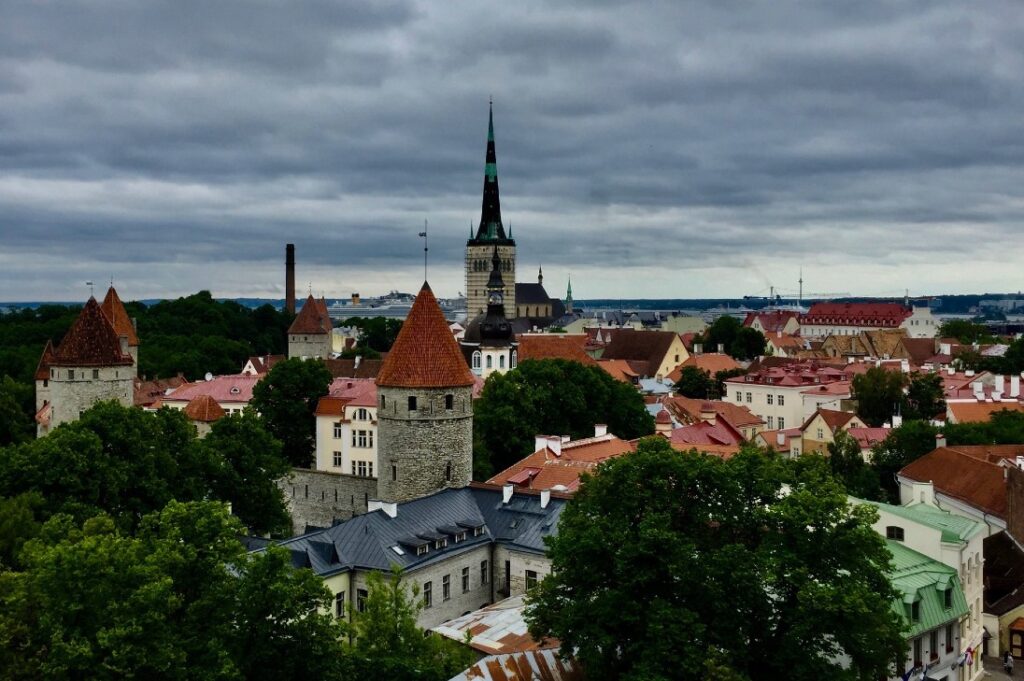
Tallinn is wonderful.
Narva and Ida-Virumaa, where I was heading, is in the very northeast of Estonia. Right by the Russian border. So after a couple of days in Tallinn, I headed east on my bicycle. After a bit of criss-crossing bicycle trails and small roads, in order to get out of Tallinn, I was finally out in the countryside.

Staying a local hostel in rural Estonia.
Estonia surprised me by being surprisingly bicycle friendly. Quite a lot of bicycle trails, all the way along the northern part of the country. And when there were no bicycle lanes, there were plenty of quiet country roads that are great for cycling.

Staying in a camping hut in northern Estonia.
I was also pleasantly surprised to see that hostels are abundant in Estonia. While I had mostly camped in Sweden, I found myself using mostly countryside hostels in Estonia. They worked really well for me and always had private rooms as well as dorms. The price level was very budget friendly and I totally enjoyed cycling around the northern part of estonia.
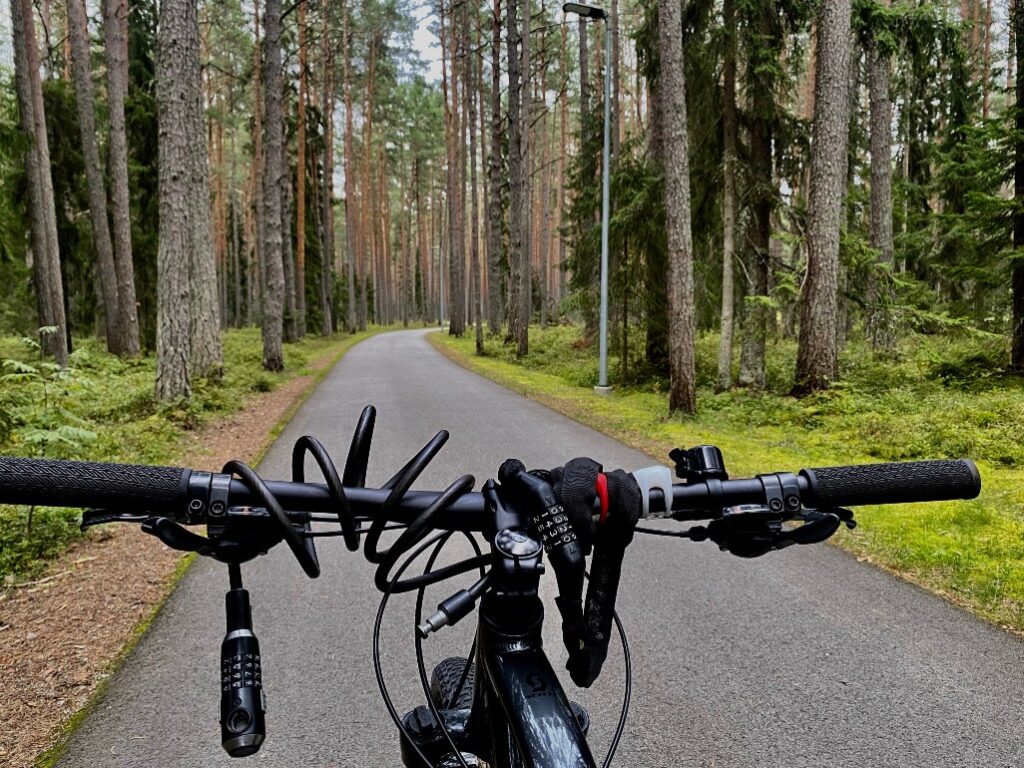
Cycling across northern Estonia.
Estonia has a lot of forests and lakes, just like Sweden. There is also some industry along the north coast of the country. Oil shale used to be the big employer and income earner in the region. There are still oil shale mines, but they are getting fewer. There are also other industries. Tourism has some real potential in this region.
I have worked within Travel & Tourism for more than 30 years and see quite a bit of potential, when it comes to outdoor tourism in the region. The locals are into the great outdoors themselves, so hopefully they will succeed in making a living from that in the future.

Garden party at Ida-Virumaa.
As I entered the region of Ida-Virumaa, I was met right away by a woman called Kadri Jalonen. Kadri works as a tourism coordinator in Ida-Virumaa and I had organised in advance that she would meet up with me, so that we could bike the last 50 kilometres to Narva together. First she set me up with another couple of locals though.

Cycling towards Narva, with Kadri joining me.
One guy was Hardi, who used to be the mayor of a small town in the region. He showed me around the mining areas, where they are busy turning some of the former oil shale mines into museums, visitor centers and they also had a new hostel by one of the former mines. Another guy called Ainar showed me the newly built oil shale museum in the town of Kohtla-Järve. Excellent museum that I can only recommend that you visit, if you are in northern Estonia.

Former oil shale mine in northern Estonia.
We finished off by having coffee with some locals in a village garden, where they had a local band playing in a private backyard. Always nice to stumble upon some local events like this, where I am greeted by some local families.

The north coast of Estonia.
On my last day of cycling towards Estonia, Kadri joined me and so did a friendly camera man, who showed up in his car several times and filmed me for Estonian television. During the ride, we came by the town of Sillamäe, which used to be a secret town during the Soviet days.
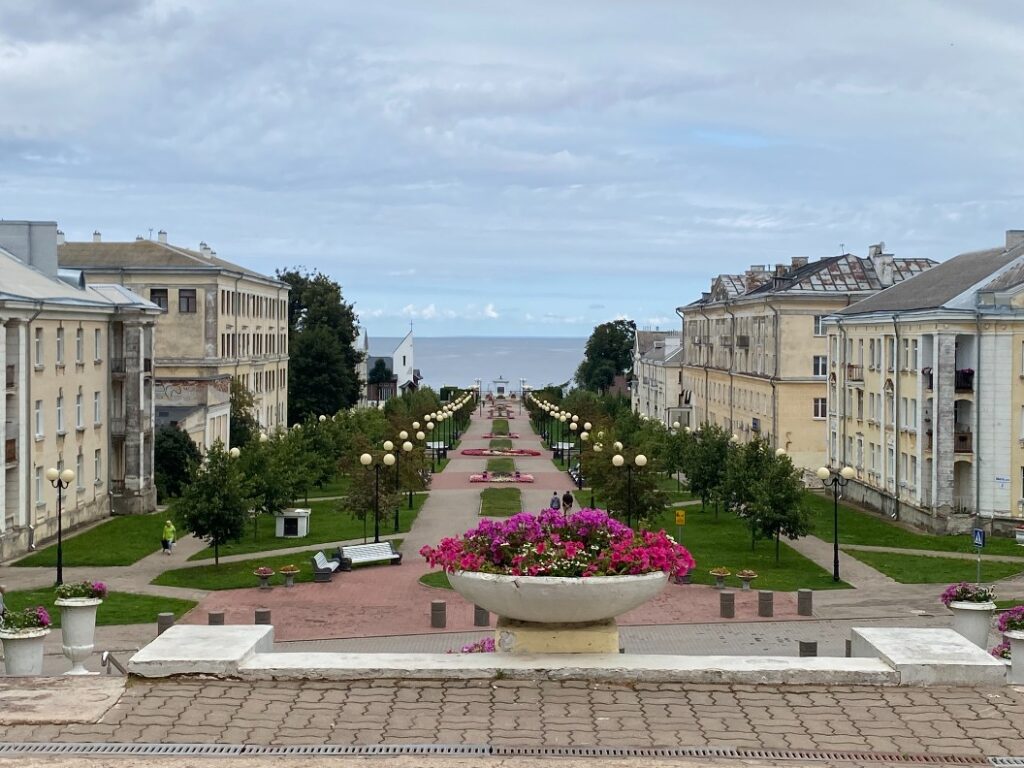
Sillamäe.
This was mainly because Sillamäe was the town where the Soviet Union started to enrich uranium for their first nuclear bombs. These days, long after the fall of the Soviet Union, the town is still inhabited almost entirely by Russians, who have decided to keep living in Sillamäe, even if the Russian and Soviet influence is gone.

Me and my bicycle in Sillamae.
Sillamäe is actually a quite pretty and very well kept town. Well worth a visit if you are in the region, I would say.

Arriving to Narva.
From Sillamäe we cycled the last few kilometres to Narva, where we were met by a local cyclist on the edge of town. He was a local grassroots activist, who had built up a cycling community in Narva, where people go on social rides in the area. Very nice guy who is enthusiastic about cycling.
We took a few photos by the city sign and then headed into the center of Narva, where we were met by a crowd of people, who had set up a whole little committee to meet me. I was greeted by people from the local authorities, as well as a few other people. We all had coffee and cake, while we were standing overlooking the river that divides Estonia and Russia.

I had a grand welcome in Narva, by some of the locals.
When you stand on the banks of River Narva, like we did, Russia is only about 200 meters away. I personally think that this spot is absolutely iconic and one of the most interesting places I have ever been. I was showered with presents and well wishes from the locals of Narva and we all went on a cycling tour of town, where a local historian showed us around and talked about Narva.

Narva is where Estonia meets Russia. Only 400 meters between the two castles in each country.
I spent the next two days visiting Narva and surroundings on my bicycle. Narva is a surprisingly interesting town. It surprises me a lot that it is left off the tourism trail by almost all western tour operators, as it really has quite a bit to offer. First of all you have the iconic setting by the Narva River, with an Estonian fort and a Russian fort being only 400 meters away from each other.

The old Krenholm factory in Narva.
In Narva you also have the old abandoned textile factory Krenholm, where a local woman from the municipality showed me around. This is urban exploration when it is really good.

Inside the abandoned Krenholm Factory.
Next to Krenholm is a place that the locals call the Narva Venice. It’s an area with a water reservoir that has a lot of canals, where locals have built little garages for their boats ,as well as small houses. This is not your usual tourist place. But it’s really cool if you ask me. And it is located within walking distance from Krenholm, which is also within walking distance of the city center. Best thing is to have a bicycle like me though. Narva has a lot of bicycle trails and is a cycling friendly town.
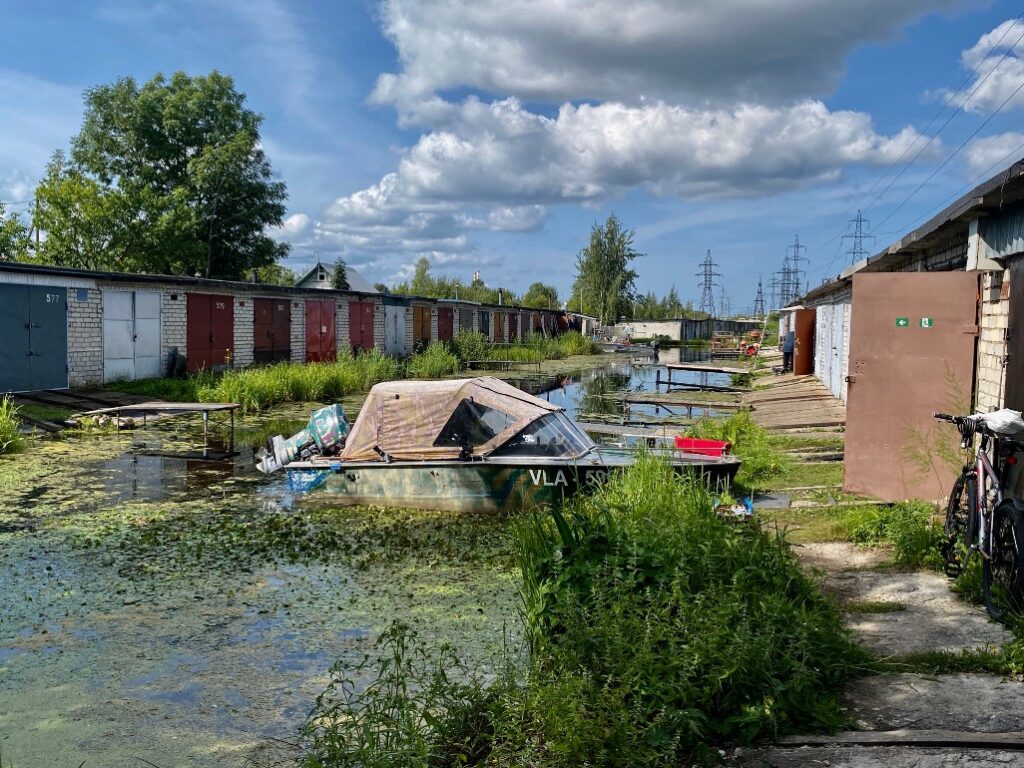
The Venice of Narva.
I also went out for dinner and drinks a couple of times, while in Narva. And there are actually some quite good restaurants in town ,as well as a few pubs, where I was able to try some local microbrews from the region, as well as from other parts of Estonia. I am a big fan of craft beer. So it was nice to see that they have a few of these breweries in the region as well.
I could easily have spent a few more days in town. But I had a flight reservation from Tallinn to Copenhagen and some work waiting for me back home. So I hopped on the train from Narva to Tallinn and flew back home, after what was an unforgettable trip. And I will be coming back to Narva for sure. Even if it is just for a weekend, as it’s a short flight from Denmark to Estonia. The train from Tallinn to Narva also stops right in front of Tallinn Airport. So going to Narva is not that hard.

I came to Narva with my bicycle and will be back.
So I will be back.
Sooner or later 🙂































